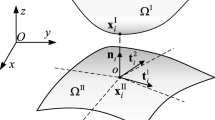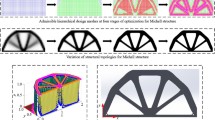Abstract
Spline-based meshfree method (SBMFM) is originated from the Isogeometric analysis (IGA) which integrates design and analysis through Non-uniform rational B-spline (NURBS) basis functions. SBMFM utilizes trimming technique of CAD system by representing the domain using NURBS curves. In this work, an explicit boundary topology optimization using SBMFM is presented with an effective boundary update scheme. There have been similar works in this subject. However unlike the previous works where semi-analytic method for calculating design sensitivities is employed, the design update is done by using topological derivatives. In this research, the topological derivative is used to derive the sensitivity of boundary curves and for the creation of new holes. Based on the values of topological derivatives, the shape of boundary curves is updated. Also, the topological change is achieved by insertion and removal of the inner holes. The presented approach is validated through several compliance minimization problems.
Similar content being viewed by others
References
M. P. Bendsøe and N. Kikuchi, Generating optimal topologies in structural design using a homogenization method, Computer Methods in Applied Mechanics and Engineering, 38 (6) (1988) 535–543.
M. P. Bendsøe, Optimal shape design as a material distribution problem, Structural Optimization, 1 (4) (1989) 193–202.
T. Belytschko, S. P. Xiao and C. Parimi, Topology optimization with implicit functions and regularization, International Journal for Numerical Methods in Engineering, 57 (8) (2003) 1177–1196.
M. Yulin and W. Xiaoming, A level set method for structural topology optimization and its applications, Advances in Engineering Software, 35 (7) (2004) 415–441.
H. A. Eschenauer, V. V. Kobelev and A. Schumacher, Bubble method for topology and shape optimization of structures, Structural Optimization, 8 (1) (1994) 42–51.
A. N. Christiansen, M. Nobel-Jørgensen, N. Aage, O. Sigmund and J. A. Bærentzen, Topology optimization using an explicit interface representation, Structural and Multidisciplinary Optimization, 49 (3) (2014) 387–399.
X. Guo, W. Zhang and W. Zhong, Doing Topology Optimization Explicitly and Geometrically—A New Moving Morphable Components Based Framework, Journal of Applied Mechanics, 81 (8) (2014) 081009.
T. J. R. Hughes, J. A. Cottrell and Y. Bazilevs, Isogeometric analysis: CAD, finite elements, NURBS, exact geometry and mesh refinement, Computer Methods in Applied Mechanics and Engineering, 194 (39–41) (2005) 4135–4195.
W. A. Wall, M. A. Frenzel and C. Cyron, Isogeometric structural shape optimization, Computer Methods in Applied Mechanics and Engineering, 197 (33-40) (2008) 2976–2988.
S. Cho and S. H. Ha, Isogeometric shape design optimization: Exact geometry and enhanced sensitivity, Structural and Multidisciplinary Optimization, 38 (1) (2009) 53–79.
B. Koo, S.-H. Ha, H.-S. Kim and S. Cho, Isogeometric Shape Design Optimization of Geometrically Nonlinear Structures, Mechanics Based Design of Structures and Machines, 41 (3) (2013) 337–358.
Y.-D. Seo, H.-J. Kim and S.-K. Youn, Isogeometric topology optimization using trimmed spline surfaces, Computer Methods in Applied Mechanics and Engineering, 199 (49–52) (2010) 3270–3296.
H.-J. Kim, Y.-D. Seo and S.-K. Youn, Isogeometric analysis for trimmed CAD surfaces, Computer Methods in Applied Mechanics and Engineering, 198 (37–40) (2009) 2982–2995.
H.-J. Kim, Y.-D. Seo and S.-K. Youn, Isogeometric analysis with trimming technique for problems of arbitrary complex topology, Computer Methods in Applied Mechanics and Engineering, 199 (45–48) (2010) 2796–2812.
J. Céa, S. Garreau, P. Guillaume and M. Masmoudi, The shape and topological optimizations connection, Computer Methods in Applied Mechanics and Engineering, 188 (4) (2000) 713–726.
S. Lee, B. Kwak and I. Kim, Smooth boundary topology optimization using B-spline and hole generation, International Journal of CAD/CAM, 7 (1) (2007).
M. Burger, B. Hackl and W. Ring, Incorporationg topological derivatives into level set methods, Jouranl of Computational Physics, 194 (1) (2004) 344–362.
S. Amstutz, Connections between topological sensitivity analysis and material interpolation schemes in topology optimization, Structural and Multidisciplinary Optimization, 43 (6) (2011) 755–765.
P. Les and W. Tiller, The NURBS book, Second Ed., Springer-Verlag, New York, USA(1997).
J. A. Cottrell, T. J. R. Hughes and Y. Bazilevs, Isogeometric Analysis: Toward Integration of CAD and FEA, Wiley(2009).
S. Lipton, J. A. Evans, Y. Bazilevs, T. Elguedj and T. J. R. Hughes, Robustness of isogeometric structural discretizations under severe mesh distortion, Computer Methods in Applied Mechanics and Engineering, 199 (5–8) (2010) 357–373.
R. Sevilla, S. Fernández-Méndez and A. Huerta, NURBSenhanced finite element method (NEFEM), International Journal for Numerical Methods in Engineering, 76 (1) (2008) 56–83.
H.-J. Kim and S.-K. Youn, Spline based meshfree method, International Journal for Numerical Methods in Engineering, 92 (9) (2012) 802–834.
P. Kang and S.-K. Youn, Isogeometric topology optimization of shell structures using trimmed NURBS surfaces, Finite Elements in Analysis and Design, 120 (1) (2016) 18–40.
A. A. Novotny, R. A. Feijóo, E. Taroco and C. Padra, Topological sensitivity analysis, Computer Methods in Applied Mechanics and Engineering, 192 (7–8) (2003) 803–829.
J. Sokolowski and A. Zochowski, On the topological derivative in shape optimization, Inria Report(1999).
K. Svanberg, The method of moving asymptotes—a new method for structural optimization, International Journal for Numerical Methods in Engineering, 24 (2) (1987) 359–373.
Author information
Authors and Affiliations
Corresponding author
Additional information
Recommended by Associate Editor Gil Ho Yoon
Junyoung Hur received B.S. and M.S. degrees in Mechanical Engineering from KAIST, Korea. He is currently a Ph.D. candidate in Mechanical Engineering at KAIST, Korea. His research interest includes design optimization through spline basis functions.
Sung-Kie Youn is a Professor of Mechanical Engineering at KAIST, Korea. He received his Ph.D. in University of Texas at Austin. He joined KAIST in 1988. His research interest include computational mechanics and design optimization.
Rights and permissions
About this article
Cite this article
Hur, J., Kang, P. & Youn, SK. Topology optimization based on spline-based meshfree method using topological derivatives. J Mech Sci Technol 31, 2423–2431 (2017). https://doi.org/10.1007/s12206-017-0440-6
Received:
Revised:
Accepted:
Published:
Issue Date:
DOI: https://doi.org/10.1007/s12206-017-0440-6




